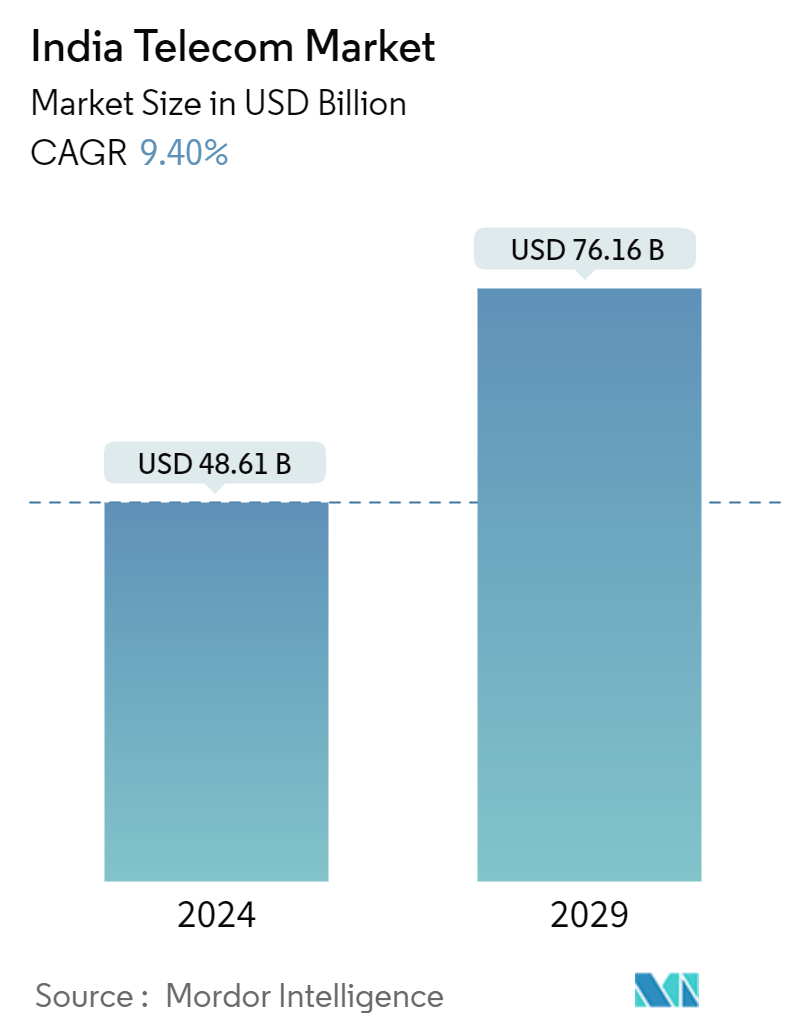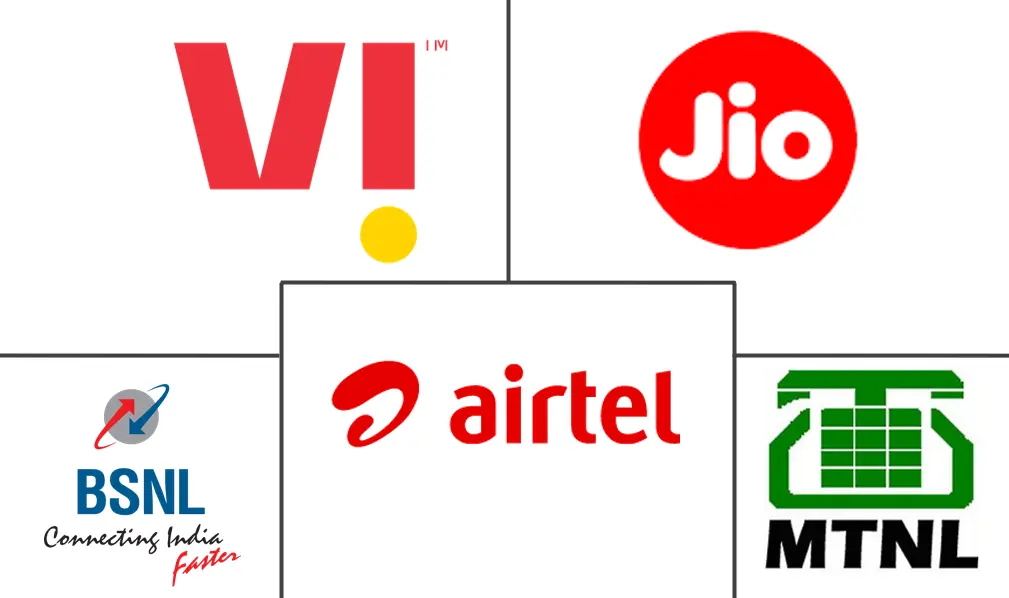| Study Period | 2019 - 2029 |
| Base Year For Estimation | 2023 |
| Forecast Data Period | 2024 - 2029 |
| Market Size (2024) | USD 48.61 Billion |
| Market Size (2029) | USD 76.16 Billion |
| CAGR (2024 - 2029) | 9.40 % |
| Market Concentration | High |
Major Players*Disclaimer: Major Players sorted in no particular order |
India Telecom Market Analysis
The India Telecom Market size is estimated at USD 48.61 billion in 2024, and is expected to reach USD 76.16 billion by 2029, growing at a CAGR of 9.40% during the forecast period (2024-2029).
The telecom sector has been undergoing a remarkable surge of expansion and advancement, with the advent of 5G technology being one of the most meaningful breakthroughs in recent years. In March 2024, the Indian telecom sector experienced a notable uptick, adding 5.6 million active subscribers. This surge represents the sector's most substantial monthly growth in the past year.
- In 2024, Jio overtook Airtel in active subscriber additions, marking a significant shift after trailing for three consecutive months. This surge in active subscribers bodes well for Airtel, especially in the wireless broadband (BB) sector, where it not only bolstered its market share but also hinted at a brighter future for its average revenue per user (ARPU). The increase in active subscribers was most pronounced in B-Circles, with an increase of 4.8 million, closely followed by C-Circles, which saw a rise of 2.3 million. In contrast, metros and A-Circles experienced setbacks, with metros witnessing a drop of approximately one million active subscribers and A-Circles reporting losses of 500,000 subscribers.
- The Indian telecom sector operates under three key laws: the Indian Telegraph Act of 1885, which covers licensing and communication interception, the Indian Wireless Telegraphy Act of 1933, governing the possession of wireless telegraph apparatus, and the 1950 Telegraph Wires (Unlawful Possession) Act, which was recently repealed by the Repealing and Amending Act of 2023, which received assent on December 17, 2023. Additionally, the Telecom Regulatory Authority of India (TRAI) Act of 1997 establishes TRAI as the sector's regulator, overseeing tariff regulations. The TRAI Act also birthed the Telecom Disputes Settlement and Appellate Tribunal (TDSAT) for dispute resolution, while the authority to issue licenses remains vested in the central government.
- The telecom sector in India is expanding due to increasing end-user applications and growth in markets like IoT, cloud, data centers, and 5G. The country is also witnessing an increase in internet consumption. Market players are developing new internet plans to fulfill the increasing demand for internet services and grab a more significant portion of the market.
- However, every industry was affected by the COVID-19 outbreak. The telecom industry was significantly impacted, as it was essential for medical, government, and private-sector commercial activities to operate seamlessly. For instance, reliable, high-speed internet access is critical in ensuring that hospitals and medical institutions access worldwide information networks and resources needed to combat the virus. Broadband access is also vital for educational institutions and enterprises to continue providing essential services.
- The COVID-19 pandemic's unexpected disruption of typical business operations prompted enterprises to operate remotely. This transition increased the demand for stronger network connectivity and internet availability, particularly in isolated or rural locations. Thus, the telecom (wireless and wireline) industry is attempting to provide better internet infrastructure to its clients. Even after the pandemic, the market is gaining traction across the country.
India Telecom Industry Segmentation
The telecom industry comprises the sales of telecom goods and services by companies (organizations, single proprietorships, and partnerships) that supply communication hardware equipment for transmitting voice, data, text, and video. The telecoms market includes the sales of items by manufacturers like GPS equipment, cellular phones, and switching equipment.
The telecom industry in India is segmented by services (voice services (wired and wireless), data and messaging services, and OTT and pay TV services).
The market sizes and forecasts are provided in value (USD) for all the above segments.
| Voice Services | Wired |
| Wireless | |
| Data and Messaging Services (Coverage to include Internet and Handset Data Packages and Package Discounts) | |
| OTT and Pay TV Services |
India Telecom Market Size Summary
The Indian telecom industry is experiencing significant growth, positioning itself as the second-largest telecom market globally. This expansion is driven by a steady increase in the subscriber base, both in wireless and wired internet subscriptions, and a rising teledensity. The sector is witnessing a surge in data consumption, propelled by the widespread adoption of smartphones and the transition from traditional phones to more advanced devices. The government's initiatives, such as the introduction of the Telecom Bill 2022 and the allocation of substantial funds for telecom infrastructure, aim to enhance the ease of doing business and improve digital connectivity. These efforts are complemented by the rollout of 5G services, which are expected to further boost the industry's growth and contribute significantly to the Indian economy.
The market is characterized by the presence of major players like Reliance Jio Infocomm, Bharti Airtel, and Vodafone Idea Limited, who are actively expanding their network capacities and deploying advanced technologies to maintain a competitive edge. The COVID-19 pandemic has accelerated the demand for robust internet connectivity, leading to increased investments in telecom infrastructure to support remote work and digital services. The sector's growth is also supported by favorable regulatory conditions, affordable data plans, and the expansion of 3G and 4G networks. As the industry continues to evolve, the focus remains on enhancing broadband services and preparing for the future with innovations like 6G technology.
India Telecom Market Size - Table of Contents
1. MARKET DYNAMICS
-
1.1 Market Drivers
- 1.1.1 Increasing Penetration of 4G and Upgradation of 5G
- 1.1.2 Foreign Direct Investment (FDI)
-
1.2 Market Restraint
- 1.2.1 Lack of Fixed Line Penetration
-
1.3 Analysis of the Market based on Connectivity (Coverage to include In-depth Trend Analysis)
- 1.3.1 Fixed Network
- 1.3.1.1 Broadband (Cable Modem, Wireline Fiber, Wireline DSL, and Fixed Wi-Fi ) and Trends regarding ADSL/VDSL, FTTP/B, Cable Modem, FWA, and 5G FWA
- 1.3.1.2 Narrowband
- 1.3.2 Mobile Network
- 1.3.2.1 Smartphone and Mobile Penetration
- 1.3.2.2 Mobile Broadband
- 1.3.2.3 2G, 3G, 4G, and 5G Connections
- 1.3.2.4 Smart Home IoT and M2M Connections
- 1.4 Analysis of Telecom Towers (Coverage to Include In-depth Trend Analysis of Various Types of Towers, like Lattice, Guyed, Monopole, and Stealth Towers)
2. MARKET SEGMENTATION
-
2.1 Segmentation by Services (Coverage to include Average Revenue Per User for the Services Segment, Market size and Estimates for Each Segment (2020-2027) and in-depth Trend Analysis)
- 2.1.1 Voice Services
- 2.1.1.1 Wired
- 2.1.1.2 Wireless
- 2.1.2 Data and Messaging Services (Coverage to include Internet and Handset Data Packages and Package Discounts)
- 2.1.3 OTT and Pay TV Services
India Telecom Market Research Faqs
How big is the India Telecom Market?
The India Telecom Market size is expected to reach USD 53.18 billion in 2025 and grow at a CAGR of 9.40% to reach USD 83.34 billion by 2030.
What is the current India Telecom Market size?
In 2025, the India Telecom Market size is expected to reach USD 53.18 billion.




